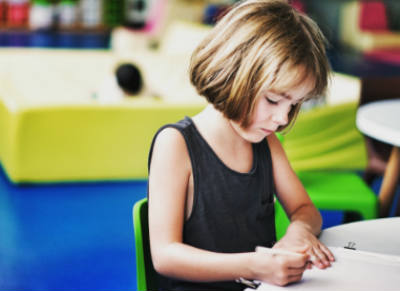When your child starts preschool, it’s normal for both of you to be excited. It’s also normal for each of you to experience symptoms of separation anxiety, perhaps at the same time you’re feeling that excitement. That’s because, when it’s time for your child to start preschool, it can be a big change. Fortunately, though, there are plenty of things you can do to help him or her adjust. 
In fact, here are five different strategies that can help your child adjust to preschool.
Tip #1: Help your child develop foundational skills.
This can be as simple as reading to your child, according to an expert quoted by the Akron Children’s Hospital, and helping him or her recognize letters and numbers, as well as colors. How? Here are several ideas:
- Give your child simple puzzles to put together
- Hold up an object and ask where that object appears in a book
- Play make-believe games
- Provide your child with multiple objects and ask for them to be sorted by shape and then by color
Tip #2: Give your child opportunities to play with other children.
Whether this means deliberately setting up playdates or allowing your child to play with other youngsters in your neighborhood, it helps to prepare your child for the social experience of preschool. Teach your child to share toys and otherwise encourage fairness and cooperation.
Tip #3: Create transition routines.
This tip comes from a PBS article, one that shares how rituals and routines can vary from family to family, but each should have the goal of facilitating a smooth transition to preschool. The comfort of these rituals can help ease separation anxiety, and they give your child something to look forward to each day. Transition routines can include:
- “special ways of saying goodbye” with certain ‘secret’ family words, gestures or hugs
- helping your child take off his or her coat before giving a goodbye hug
- teaching your child that “goodbye” is really another way of saying, “I’ll be back later.”
Consider what routines comfort your child at bedtime or when a babysitter is coming over. How can you adapt them to reduce separation anxiety as your child adjusts to preschool?
Tip #4: Visit the preschool together.
Spend time there together, giving your child time to feel secure in the setting and a chance to get to know his or her teachers. If your child sees you having a friendly conversation with a teacher, this can reassure him or her. Let your child see each of the rooms in the preschool center, as well, including the kitchen and the bathroom. Share how, in many ways, the preschool is like your house.
Tip #5: Play disappearing games.
This final tip comes from Scholastic.com. You can do something as simple as rolling a ball under the couch and saying, “We can’t see the ball anymore. Is it still here?” When your child finds the ball, you can say, “Even when you can’t see something, it’s still there. So, even though you can’t see Mommy while you’re at preschool, I’ll be back.”
These kinds of games reinforce the concept of object permanence. Your preschooler almost certainly understands that concept already but, during a big change–especially one that can be emotional–it doesn’t hurt to reinforce the concept in a fun yet reassuring way.
Photo by pan xiaozhen on Unsplash.




